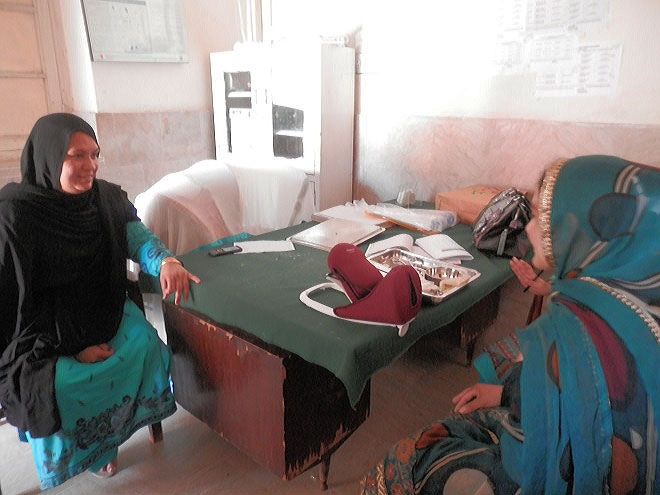
Lahore, Pakistan–Ayesha Sohail owns a small private health clinic in the Samanabad area of central Lahore in Punjab province. There, this Lady Health Visitor—a position similar to a skilled birth attendant in other parts of the world, with nearly three years of training—provides care and counseling to numerous women.
An advocate for family planning, Ayesha was recently trained on the postpartum intrauterine contraceptive device (PPIUCD) through the Jhpiego-led Saving Lives at Birth project. She was one of 88 care providers, among doctors, nurses, midwives and other Lady Health Visitors, to receive this training.
Saving Lives at Birth uses a portable, low-cost simulation model, “Mama-U,” to facilitate effective training on the correct insertion and placement of IUCDs after childbirth. Developed in a collaboration between Jhpiego and Laerdal Global Health, the Mama-U gives health care providers like Ayesha the chance for hands-on practice—a critical step in building confidence for a family planning method that is relatively new to most Pakistani health workers.
“The model provided by Jhpiego improved my confidence on PPIUCD insertion, and most importantly, strengthened my counseling impact, as the myths and misconceptions my patients have are easily erased,” says Ayesha.
Ayesha’s statement reflects the findings of a Jhpiego-led study of the impact of the Mama-U simulation model on training. The study found that 82 percent of the 88 providers trained using the Mama-U model stated that they felt confident in providing PPIUCD services. In addition, 78.6 percent of the clients who were shown the model during the study said that the Mama-U demonstration helped them decide to accept a PPIUCD, according to the study’s findings.
Ayesha’s new skills and confidence were tested when she met a 36-year-old mother of two children who was pregnant. The woman had struggled just to make ends meet in her own life and, like many women in Pakistan, her encounters with any kind of maternal health care were rare. That left her without access to information on healthy birth spacing and vulnerable to unsafe and illicit abortion practitioners.
“I remember when she came to my clinic six months back … she was weak and pale, and begged me for an abortion. She already underwent many abortions during the past few years with the help of untrained persons,” recalls Ayesha, whose training had prepared her to address postabortion care health issues.
Using her skills, Ayesha began to discuss with the woman steps toward improved health, the impact of healthy birth spacing on both a mother and her family, and the health-related complications of terminating a pregnancy. “Though it seemed hopeless to change her mind, I decided to take this challenge,” Ayesha says.
During the woman’s prenatal care visits, Ayesha explained the safe and healthy methods of birth spacing, including oral and injectable contraceptives, and the PPIUCD, which can offer protection for up to 10–12 years and be inserted immediately after the birth of a child. A permanent family planning method, tubal ligation, also was discussed but the woman rejected that because it is irreversible, says Ayesha.
“Initially, she was not convinced” on the benefits of a long-acting family planning method. “But I continued counseling her on every visit, and managed to change her mind,” the health worker says. One of the most important moments in the counseling, Ayesha recalls, was using the Mama-U to describe the procedure to insert an IUCD. “It was remarkable to see the result of using a small, simple PPIUCD model for her counseling,” Ayesha says.
The woman decided to continue her pregnancy and chose a PPIUCD at birth, and she credits Ayesha’s perseverance and confidence with helping her. “I felt wonderful this time,” the woman says. “I got the strength to give life, and it is due to the repeated efforts of Ayesha.”



